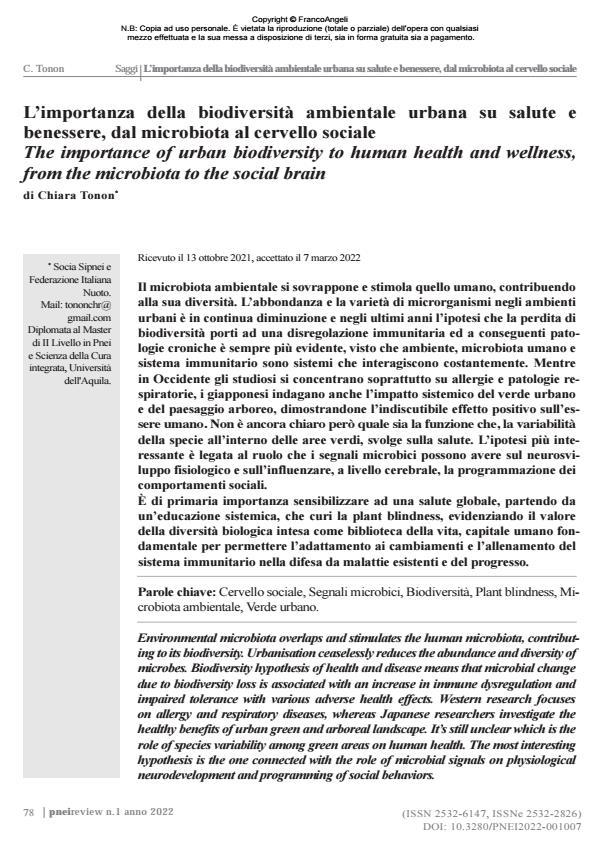L’importanza della biodiversità ambientale urbana su salute e benessere, dal microbiota al cervello sociale
Titolo Rivista PNEI REVIEW
Autori/Curatori Chiara Tonon
Anno di pubblicazione 2022 Fascicolo 2022/1
Lingua Italiano Numero pagine 16 P. 78-93 Dimensione file 519 KB
DOI 10.3280/PNEI2022-001007
Il DOI è il codice a barre della proprietà intellettuale: per saperne di più
clicca qui
Qui sotto puoi vedere in anteprima la prima pagina di questo articolo.
Se questo articolo ti interessa, lo puoi acquistare (e scaricare in formato pdf) seguendo le facili indicazioni per acquistare il download credit. Acquista Download Credits per scaricare questo Articolo in formato PDF

FrancoAngeli è membro della Publishers International Linking Association, Inc (PILA)associazione indipendente e non profit per facilitare (attraverso i servizi tecnologici implementati da CrossRef.org) l’accesso degli studiosi ai contenuti digitali nelle pubblicazioni professionali e scientifiche
Il microbiota ambientale si sovrappone e stimola quello umano, contribuendo alla sua diversità. L’abbondanza e la varietà di microrganismi negli ambienti urbani è in continua diminuzione e negli ultimi anni l’ipotesi che la perdita di biodiversità porti ad una disregolazione immunitaria ed a conseguenti patologie croniche è sempre più evidente, visto che ambiente, microbiota umano e sistema immunitario sono sistemi che interagiscono costantemente. Mentre in Occidente gli studiosi si concentrano soprattutto su allergie e patologie respiratorie, i giapponesi indagano anche l’impatto sistemico del verde urbano e del paesaggio arboreo, dimostrandone l’indiscutibile effetto positivo sull’essere umano. Non è ancora chiaro però quale sia la funzione che, la variabilità della specie all’interno delle aree verdi, svolge sulla salute. L’ipotesi più interessante è legata al ruolo che i segnali microbici possono avere sul neurosviluppo fisiologico e sull’influenzare, a livello cerebrale, la programmazione dei comportamenti sociali. È di primaria importanza sensibilizzare ad una salute globale, partendo da un’educazione sistemica, che curi la plant blindness, evidenziando il valore della diversità biologica intesa come biblioteca della vita, capitale umano fondamentale per permettere l’adattamento ai cambiamenti e l’allenamento del sistema immunitario nella difesa da malattie esistenti e del progresso.
Parole chiave:Cervello sociale, Segnali microbici, Biodiversità, Plant blindness, Microbiota ambientale, Verde urbano.
Chiara Tonon, L’importanza della biodiversità ambientale urbana su salute e benessere, dal microbiota al cervello sociale in "PNEI REVIEW" 1/2022, pp 78-93, DOI: 10.3280/PNEI2022-001007